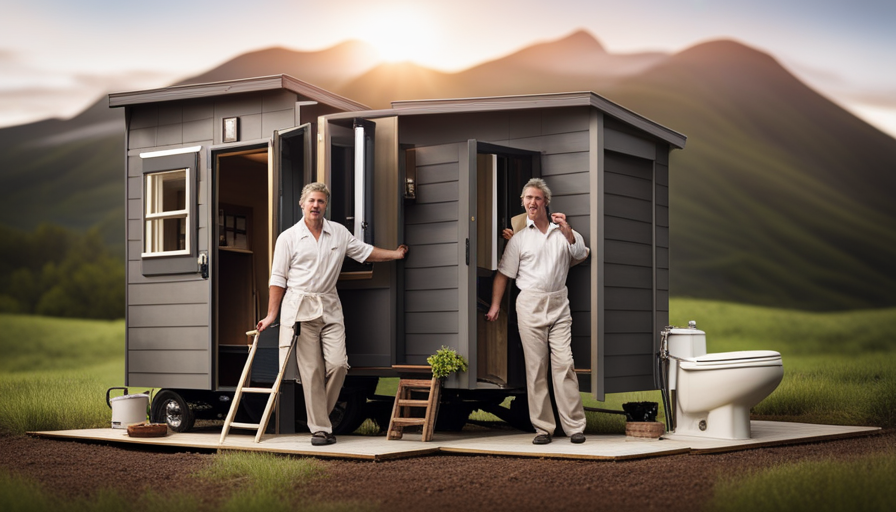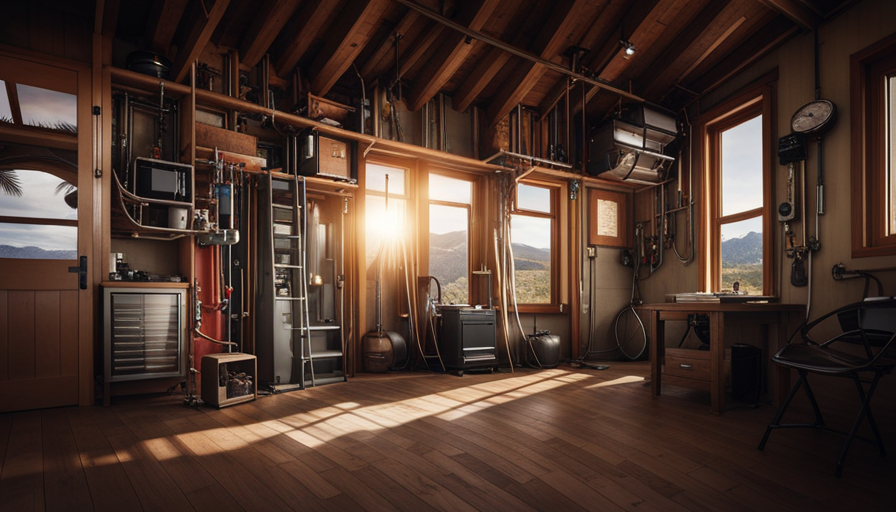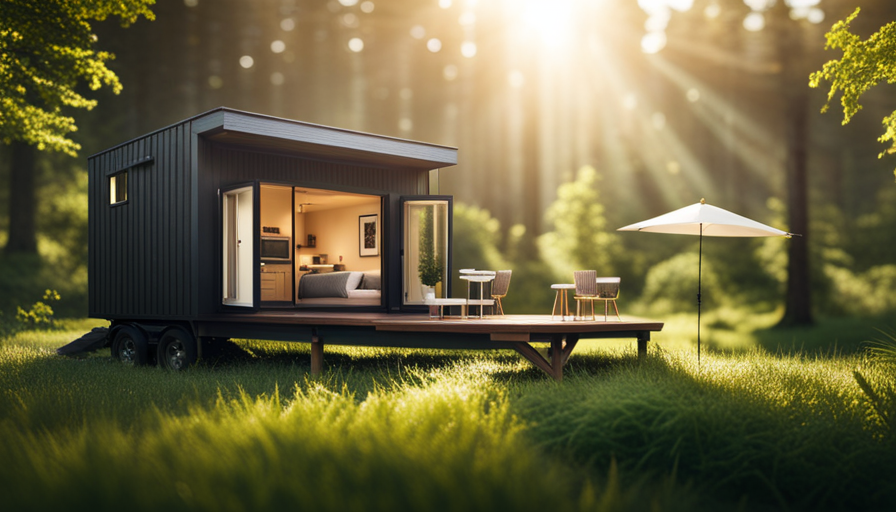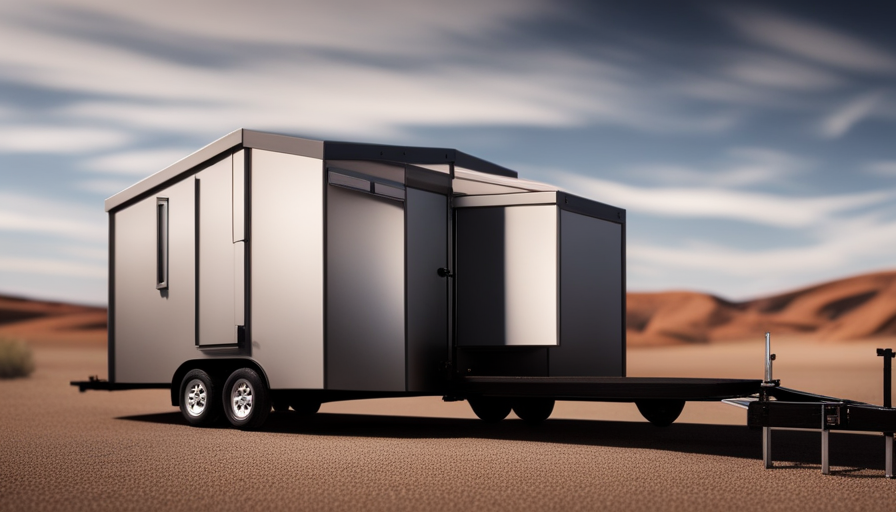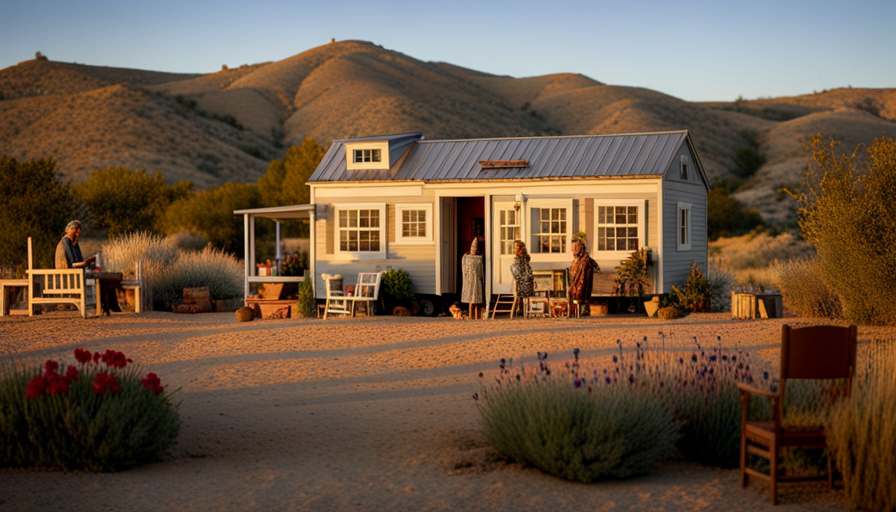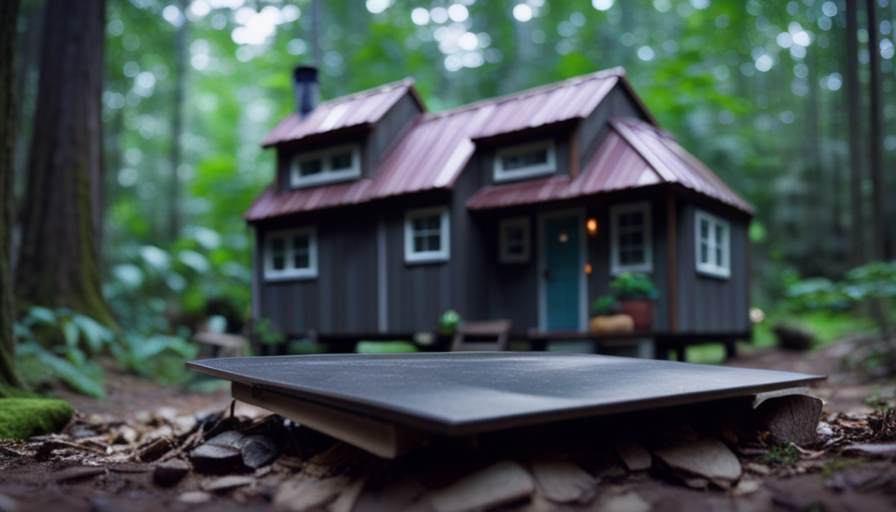Are you ready to take on the challenge of installing plumbing in a small house bathroom? Get ready to dive into the world of tiny house living and master the art of efficient plumbing.
In this article, we will guide you through the process of plumbing a tiny house toilet, from choosing the right type of toilet to connecting it to the water supply and drainage system. With our detailed instructions and helpful tips, you’ll be able to tackle this task with confidence and precision.
We will also provide troubleshooting advice for common issues and ensure you understand the importance of complying with local building codes and regulations.
So, let’s roll up our sleeves and get started on this exciting journey of plumbing a tiny house toilet!
Key Takeaways
- Types of toilets suitable for tiny houses: composting toilets and remote composting systems
- Considerations for plumbing a tiny house toilet: available space, water supply, and drainage system
- Planning the layout and placement of the toilet: selecting a suitable location, ensuring easy access to water and drainage lines
- Off-the-grid options for tiny house toilets: composting or incinerating toilets, waterless toilets
Types of Toilets Suitable for Tiny Houses
Let’s explore the different types of toilets that are perfect for tiny houses! When it comes to waterless toilets, there are a few options to consider.
One popular choice is a composting toilet, which uses the natural process of decomposition to break down waste into nutrient-rich compost. These toilets typically have two chambers – one for solid waste and one for liquid waste. The solid waste chamber is equipped with a venting system that helps control odor and promote decomposition.
Another option is a remote composting system, where the toilet is connected to a separate composting unit located outside the tiny house. This allows for easier maintenance and eliminates the need for regular emptying. Remote composting systems often use an electric fan to promote air circulation and aid in the composting process.
Now, let’s transition into the next section about considerations for plumbing a tiny house toilet.
Considerations for Plumbing a Tiny House Toilet
When it comes to setting up the plumbing for your compact commode, one key factor to consider is the available space for installation. In order to successfully complete the plumbing installation for your tiny house toilet, you need to carefully plan the layout and placement. Here are some considerations to keep in mind:
-
Water Supply: Before you begin the plumbing installation, make sure you have a reliable water supply. This can be connected to a city water line or a well if you’re in a more remote location. Ensure that the water supply is easily accessible and can provide enough water pressure for the toilet to function properly.
-
Drainage System: A proper drainage system is crucial for the toilet to function efficiently. Ensure that you have a suitable drain line that can handle the waste and water from the toilet. This may involve connecting to an existing septic system or installing a separate holding tank.
By carefully considering these factors and planning the layout and placement of your tiny house toilet, you can ensure a successful plumbing installation. In the next section, we’ll discuss the steps involved in planning the layout and placement of the toilet.
Planning the Layout and Placement of the Toilet
When planning the layout and placement of the toilet in your tiny house, there are several key points to consider. First, you need to carefully select the location within the tiny house that will accommodate the toilet comfortably and efficiently.
Secondly, you must ensure easy access to water and drainage lines to properly connect the toilet to the plumbing system.
Lastly, privacy and noise considerations should be taken into account to create a comfortable and functional bathroom space.
Location within the Tiny House
The toilet in a tiny house is typically located in a compact bathroom space. Designing a compact bathroom layout is crucial in maximizing space efficiency in a tiny house bathroom. When planning the location of the toilet within a tiny house, there are a few key considerations to keep in mind. First, it is important to ensure that there is enough room for the toilet to be easily accessed and used. Secondly, the toilet should be positioned in a way that allows for proper ventilation and privacy. Lastly, it is essential to take into account the placement of the water supply and drainage lines to ensure efficient plumbing. By carefully considering these factors, you can create a functional and comfortable bathroom space in your tiny house. In the next section, we will discuss access to water and drainage lines.
Access to Water and Drainage Lines
Having easy access to water and drainage lines is crucial for creating a functional and enjoyable bathroom space in your tiny house. When it comes to water supply options, there are a few different routes you can take.
One option is to connect your tiny house to a traditional water supply system, either through a direct connection or a hose hookup. Another option is to utilize a water storage tank, which can be filled manually or connected to a rainwater harvesting system.
As for wastewater treatment methods, you can choose between a traditional septic system or a composting toilet. Both options have their pros and cons, so it’s important to consider factors such as space, maintenance, and local regulations.
With the water supply and wastewater treatment sorted, you can now move on to considering privacy and noise considerations in your tiny house bathroom.
Privacy and Noise Considerations
For a more serene and intimate bathroom experience, consider incorporating elements that enhance privacy and minimize noise in your compact living space. Here are some privacy considerations and noise reduction techniques to help you enjoy your tiny house toilet:
-
Privacy considerations:
- Install a solid door that locks securely to ensure privacy.
- Use frosted or textured glass for windows to allow natural light while maintaining privacy.
- Place curtains or blinds on windows for added privacy.
-
Noise reduction techniques:
- Install soundproof insulation in the walls to minimize noise transfer.
- Use a soft-close toilet seat to prevent loud slamming.
- Consider using a bidet toilet seat instead of a traditional flush toilet to reduce flushing noise.
With these privacy considerations and noise reduction techniques, you can create a tranquil bathroom space in your tiny house. As you move forward with installing the toilet and connecting to the water supply, keep in mind the importance of maintaining a peaceful and quiet environment.
Installing the Toilet and Connecting to Water Supply
To plumb a tiny house toilet, start by positioning the toilet bowl in the desired location and connecting it to the water supply using flexible hoses. When it comes to toilet installation tips, it’s important to ensure that the toilet is level and securely fastened to the floor to prevent any wobbling or leaks.
To connect the toilet to the water supply, there are a few methods you can use. One option is to connect the flexible hoses directly to the water supply valve, which allows for easy installation and maintenance. Another option is to use a water supply line that connects to the toilet tank, providing a more secure connection. Whichever method you choose, make sure to follow the manufacturer’s instructions and use the appropriate fittings and seals to prevent any water leaks.
Once the toilet is connected to the water supply, you can move on to connecting it to the drainage system, which will be discussed in the next section.
Connecting the Toilet to the Drainage System
To connect the toilet to the drainage system in your tiny house, you’ll need to install a drain pipe. This pipe should be properly sloped to ensure that waste and water flow smoothly towards the main sewer line or septic tank.
Additionally, it’s important to ensure proper ventilation to prevent any foul odors or gas buildup.
Installing the Drain Pipe
Ironically, connecting the drain pipe for a tiny house toilet is a task that requires careful measurement and precision. To ensure a smooth installation, follow these steps:
-
Measure the distance from the toilet flange to the main drain line. This will determine the length of the drain pipe needed.
-
Choose the right type and size of drain pipe. PVC pipes are commonly used for their durability and ease of installation.
-
Cut the drain pipe to the appropriate length using a PVC cutter or a hacksaw.
-
Connect the drain pipe to the toilet flange, making sure to achieve a secure and leak-free connection.
Proper slope and ventilation are crucial for the efficient functioning of the drainage system. With the drain pipe installed, it’s essential to focus on achieving the correct slope and ensuring proper ventilation for effective waste removal and prevention of foul odors.
Proper Slope and Ventilation
Achieving the proper slope and ensuring adequate ventilation in your drainage system is essential for efficient waste removal and preventing unpleasant odors. To maintain the proper slope, the drain pipe should be installed at a slight downward angle. This ensures that gravity can assist in the flow of waste and water. Regular slope maintenance is crucial to prevent clogs and backups.
Additionally, proper ventilation is necessary to release any trapped gases and prevent the buildup of unpleasant odors. Ventilation requirements typically include the installation of a vent pipe, which allows for the release of gases outside the tiny house.
With the proper slope and ventilation in place, you can now move on to connecting your tiny house toilet to the main sewer line or septic tank, ensuring a fully functional plumbing system.
Connecting to the Main Sewer Line or Septic Tank
Now, let’s dive into the crucial step of connecting your drainage system to either the main sewer line or septic tank, ensuring a seamless and efficient waste removal process.
When connecting to the city sewer, you’ll need to locate the nearest sewer line and determine if it’s accessible from your tiny house. You’ll then need to dig a trench and lay the necessary pipes, making sure they have the proper slope for gravity to carry the waste away.
On the other hand, if you’re connecting to a septic system, you’ll need to locate the septic tank and determine the best route to connect your tiny house. You’ll need to install a sewer pipe from your toilet to the septic tank, ensuring proper ventilation and adhering to local regulations.
Consider off-the-grid options for tiny house toilets, such as composting or incinerating toilets, to further reduce your environmental impact.
Considering Off-the-Grid Options for Tiny House Toilets
If you’re considering off-the-grid options for your tiny house toilet, there are a few key points to keep in mind. First, waterless toilets are an excellent choice as they don’t require any water or plumbing connections.
Composting toilets with remote systems are also a popular option. They use natural processes to break down waste and can be used even in remote locations.
Finally, incinerating toilets with off-grid power sources offer a convenient and sanitary solution. They burn waste to ash and require minimal maintenance.
Waterless Toilets
To plumb a tiny house toilet, you can simply install a waterless toilet that doesn’t require any water for flushing. Waterless toilets are a great option for off-the-grid living as they eliminate the need for water supply and plumbing infrastructure.
There are various waterless toilet options available, such as composting toilets, incinerating toilets, and dry toilets. One of the main benefits of waterless toilets is their environmental friendliness, as they conserve water and reduce wastewater. Additionally, they’re easy to install and maintain, requiring minimal upkeep.
Composting toilets with remote systems, which we’ll discuss in the next section, take the waterless concept a step further by converting human waste into compost, making them even more sustainable and self-sufficient.
Composting Toilets with Remote Systems
Imagine having a composting toilet with a remote system in your tiny house, where human waste is converted into nutrient-rich compost, creating a self-sufficient and sustainable solution for your bathroom needs.
Remote controlled composting toilets offer convenience and ease of use in managing waste. These systems typically consist of a composting chamber, a ventilation system, and a remote control panel. With DIY composting toilet systems, you have the freedom to design and customize your own setup according to your specific requirements.
The remote control panel allows you to monitor and adjust temperature, humidity, and ventilation settings remotely, ensuring optimal composting conditions. By maintaining the right balance of moisture and oxygen, these toilets efficiently break down waste into compost.
This remote system eliminates the need for manual management and provides a hassle-free experience. Moving on to incinerating toilets with off-grid power sources, these toilets offer an alternative solution for waste disposal.
Incinerating Toilets with Off-grid Power Sources
With an incinerating toilet and an off-grid power source, you can literally burn through your waste, ensuring a clean and efficient disposal method for your bathroom needs.
Incinerating toilets are a popular alternative to composting toilets due to their ability to completely eliminate waste through high-temperature combustion. Unlike composting toilets, incinerating toilets don’t require the use of water or the need for regular maintenance.
However, there are some drawbacks to consider. Incinerating toilets require a power source, and when it comes to off-grid options, solar and wind energy are the most common choices. Solar power is reliable and easy to install, while wind energy can be more unpredictable and dependent on weather conditions.
Ultimately, the choice between incinerating toilets and composting toilets, as well as the power source, will depend on your specific needs and preferences. As you consider these options, it’s important to also understand how to maintain and clean your tiny house toilet.
Maintaining and Cleaning a Tiny House Toilet
To maintain and clean your tiny house toilet, regular cleaning and sanitization are crucial. This involves cleaning the toilet bowl, seat, and any other surfaces with a disinfectant cleaner.
Additionally, it’s important to empty and maintain composting toilets properly by regularly adding composting materials and removing compost when necessary.
Finally, proper disposal of waste is essential, whether it’s through composting, using a septic system, or disposing of it in a designated area following local regulations.
Regular Cleaning and Sanitization
Maintaining a squeaky-clean tiny house toilet is essential for a fresh and hygienic living space. To ensure regular maintenance, follow these steps:
- Use a toilet brush and a mild cleaning solution to scrub the inside of the toilet bowl.
- Wipe down the exterior surfaces of the toilet using a disinfectant spray or wipes.
- Pay special attention to the seat, hinges, and flushing mechanism, ensuring they’re thoroughly cleaned and sanitized.
- For stubborn stains or mineral buildup, use a non-abrasive cleaner and a scrub brush.
By regularly cleaning and sanitizing your tiny house toilet, you can prevent unpleasant odors and bacterial growth. This will provide a more pleasant and comfortable bathroom experience.
Now, let’s move on to the next section about emptying and maintaining composting toilets.
Emptying and Maintaining Composting Toilets
Emptying and maintaining composting toilets can be a challenging task, but it’s worth it for a more eco-friendly and efficient bathroom system. To ensure proper functioning, it is crucial to follow best practices for maintaining composting toilets. Here is a table summarizing key steps to empty and maintain composting toilets:
| Step | Description |
|---|---|
| Emptying | Carefully remove the compost from the toilet and transfer it to a compost bin or designated area. Avoid contact with skin or inhaling dust. |
| Cleaning | Thoroughly clean the toilet bowl and surfaces with eco-friendly disinfectants. Ensure proper ventilation during cleaning. |
| Adding bulking agent | Regularly add a bulking agent like sawdust or peat moss to aid in composting and control odor. |
| Monitoring moisture | Check the moisture level of the compost regularly to maintain optimal conditions for decomposition. Adjust as necessary. |
Properly maintaining composting toilets is essential for their longevity and effectiveness. Next, we will discuss the proper disposal of waste to complete the waste management cycle.
Proper Disposal of Waste
Now that you understand the process of emptying and maintaining composting toilets, it’s important to discuss the proper disposal of waste. Waste management is a critical aspect of tiny house living, as it not only ensures a clean and hygienic environment but also minimizes the environmental impact.
When it comes to disposing of waste from your tiny house toilet, it is essential to follow local regulations and guidelines. This may include using designated waste disposal facilities or composting systems that are specifically designed for human waste. Proper waste disposal not only prevents contamination of water sources and soil but also helps in the decomposition process, turning waste into valuable compost.
By responsibly managing waste, you contribute to a sustainable and eco-friendly lifestyle.
Now, let’s move on to the next section, where we will discuss troubleshooting common issues with tiny house toilets.
Troubleshooting Common Issues with Tiny House Toilets
To troubleshoot common issues with your tiny house toilet, start by checking the water supply valve for any leaks or blockages. If there’s a leak, tighten the valve or replace it if necessary. If the valve isn’t the issue, move on to troubleshooting clogged toilets.
First, use a plunger to try and clear the clog. Apply firm, even pressure to create a tight seal and push and pull the plunger vigorously. If the clog persists, try using a toilet auger to remove it. Insert the auger into the toilet bowl and rotate the handle clockwise to break up and remove the clog.
In addition to troubleshooting clogged toilets, it’s also important to address leaks in the toilet. Check the toilet tank and bowl for any cracks or worn-out seals. If you find any issues, replace the damaged parts to prevent leaks. Make sure all connections between the toilet and the plumbing system are secure and properly sealed.
Once you’ve addressed these common issues with your tiny house toilet, it’s crucial to ensure compliance with local building codes and regulations. This ensures that your plumbing system meets the necessary standards and maintains proper functionality.
Ensuring Compliance with Local Building Codes and Regulations
Ensuring compliance with local building codes and regulations is essential for maintaining the proper functionality of your plumbing system, as it guarantees that your installation meets the necessary standards and regulations.
When it comes to plumbing a tiny house toilet, it’s important to follow these building code compliance guidelines and local regulations:
-
Determine the required clearances: Building codes typically specify the minimum distances that need to be maintained between the toilet and other fixtures, walls, and any obstructions. These clearances ensure proper access and prevent any potential issues.
-
Install proper ventilation: Adequate ventilation is crucial for maintaining good indoor air quality and preventing the buildup of unpleasant odors. Make sure to install ventilation fans or windows that comply with local regulations.
-
Use approved materials: Building codes often require the use of specific materials for plumbing installations. Ensure that you choose materials that meet the required standards and are approved for use in your area.
-
Obtain necessary permits: Before starting any plumbing work, check with your local building department to determine if permits are required. Obtaining the necessary permits ensures that your installation is done in compliance with local regulations.
By ensuring compliance with building codes and local regulations, you can be confident that your tiny house toilet plumbing is up to standard. This will help prevent potential issues and ensure the proper functioning of your plumbing system.
Moving on to the next section, we’ll explore resources and recommendations for tiny house toilet plumbing.
Resources and Recommendations for Tiny House Toilet Plumbing
If you want to make your tiny house bathroom experience efficient and enjoyable, check out these helpful resources and recommendations for plumbing.
When it comes to toilet options for your tiny house, there are a few things to consider. One option is a composting toilet, which is a popular choice for tiny houses due to its water-saving and eco-friendly features. Composting toilets use natural processes to break down waste into compost, eliminating the need for plumbing and water connections.
Another option is a dry flush toilet, which uses a small amount of water to seal waste in a disposable bag. This option is easy to install and maintain, but you’ll need to regularly replace the bags.
When it comes to plumbing challenges in tiny house bathrooms, space is often a major constraint. It’s important to carefully plan the layout to ensure that all the necessary plumbing connections can be made. Additionally, you’ll need to consider how to handle wastewater disposal. Some options include connecting to a septic system, using a holding tank, or utilizing a greywater system for non-toilet wastewater.
To ensure a successful plumbing installation in your tiny house, it’s recommended to consult with a professional plumber who has experience working with small spaces. They can provide guidance on the best toilet and plumbing options for your specific needs. Additionally, there are numerous online resources and forums dedicated to tiny house plumbing that can provide valuable information and tips.
Frequently Asked Questions
Can I use a regular-sized toilet in a tiny house?
Yes, you can use a regular-sized toilet in a tiny house, but there are some plumbing requirements to consider.
Firstly, ensure that your tiny house has the necessary space and structural support for a regular-sized toilet.
You will also need to connect the toilet to a plumbing system that can handle the waste and water requirements.
Additionally, make sure to follow local building codes and regulations for plumbing installations in tiny houses to ensure proper functionality and compliance.
How much water does a typical tiny house toilet use per flush?
Water saving toilets are a great option for tiny houses. They use significantly less water per flush compared to regular-sized toilets. The average tiny house toilet uses about 0.8 to 1 gallon of water per flush, which is much less than the 1.6 gallons used by standard toilets.
Alternative toilet options, such as composting toilets or incinerating toilets, can also be considered to further conserve water in your tiny house.
Can I install a composting toilet in my tiny house?
Yes, you can install a composting toilet in your tiny house. Composting toilet installation involves setting up a self-contained system that decomposes waste into organic matter. These toilets offer several benefits, including water conservation, minimal odor, and the ability to reuse the resulting compost as fertilizer. To install a composting toilet, you’ll need to carefully follow the manufacturer’s instructions, which typically involve connecting ventilation pipes and ensuring proper airflow for decomposition.
What are the pros and cons of using a macerating toilet in a tiny house?
The pros of using a macerating toilet in a tiny house are its compact size, which saves space, and its versatility in installation options. It can be easily installed in unconventional locations or areas with limited access to plumbing.
However, there are some cons to consider. Macerating toilets require electricity to operate, which can be a drawback in off-grid situations. Additionally, they have a higher maintenance requirement, and the noise level may be bothersome.
The environmental impact of macerating toilets in tiny houses is relatively low, as they use less water compared to traditional flush toilets.
Are there any regulations or restrictions on the type of toilet I can use in a tiny house?
When it comes to regulations on tiny house toilets, there are some restrictions you need to be aware of. The type of toilet you can use may vary depending on local building codes and regulations.
However, there are alternative toilet options available for tiny houses, such as composting toilets, incinerating toilets, and macerating toilets. These options provide efficient waste management solutions while adhering to any restrictions or regulations in place.
Conclusion
So there you have it, the intricate process of plumbing a tiny house toilet. It may seem like a daunting task, but with careful planning and attention to detail, you can successfully navigate the world of miniature plumbing.
From selecting the right toilet to connecting it to the water supply and drainage system, every step requires precision. And let’s not forget about ensuring compliance with local building codes, because who doesn’t love a good bureaucracy?
So go forth, intrepid tiny house owner, and conquer the plumbing challenges that await you!
Hi, I’m Emma. I’m the Editor in Chief of Tiny House 43, a blog all about tiny houses. While tree houses are often associated with childhood, they can be the perfect adult retreat. They offer a cozy space to relax and unwind, surrounded by nature. And since they’re typically built on stilts or raised platforms, they offer stunning views that traditional homes simply can’t match. If you’re looking for a unique and romantic getaway, a tree house tiny house might just be the perfect option.
